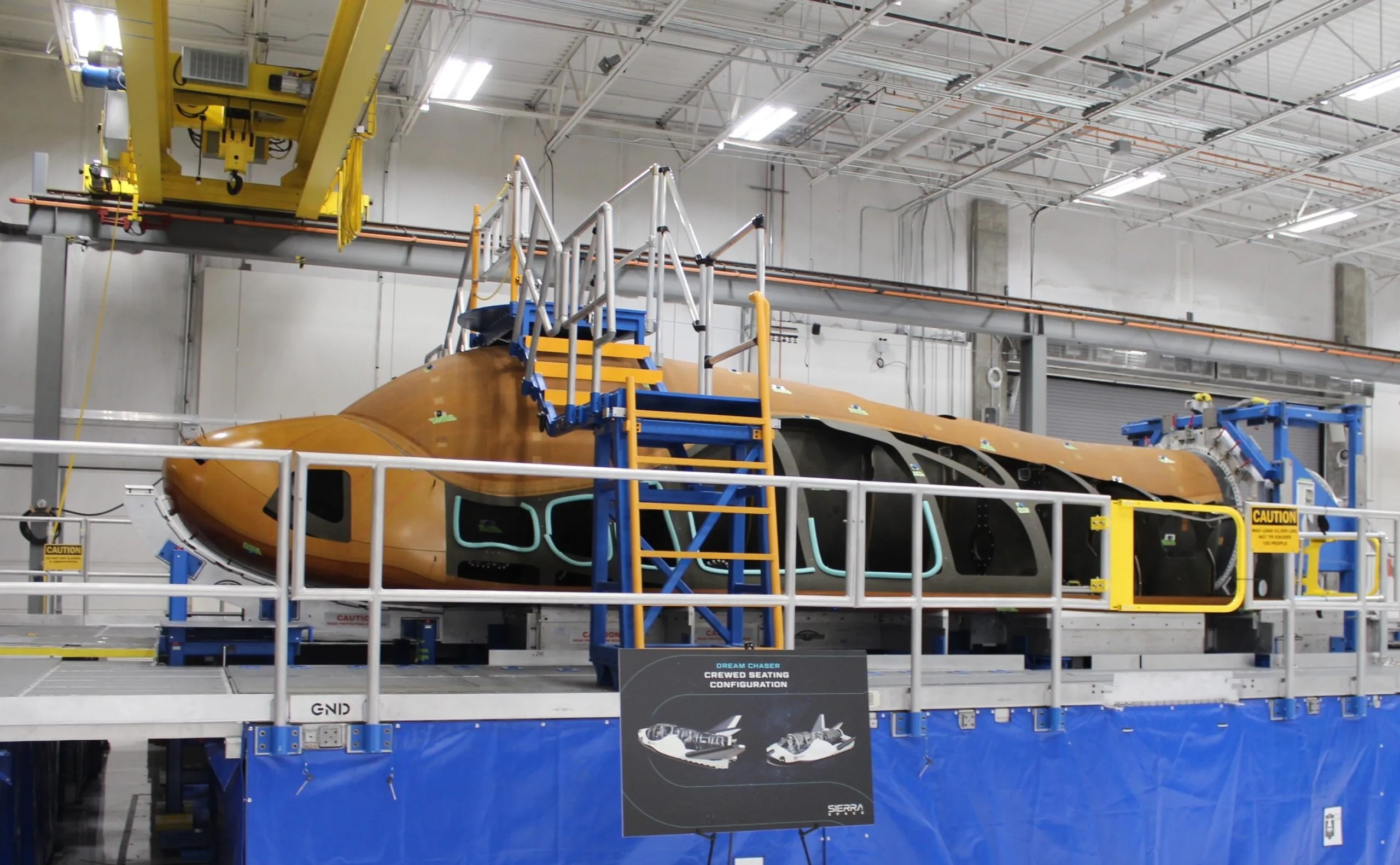9.11.2024

Reverence, the second Dream Chaser spaceplane, under construction at Sierra Space’s factory in Louisville, Colorado. Credit: Barbara David
LOUISVILLE, Colorado — The long-awaited inaugural cargo flight of Sierra Space’s Dream Chaser spaceplane has been delayed to no earlier than May 2025, pushing back a launch previously expected this year. In the meantime, Sierra Space is moving forward with its second cargo spaceplane, Reverence, alongside work on an array of inflatable habitats and other structures to meet growing demand for in-space infrastructure.
The inaugural flight will send the spaceplane Tenacity to the International Space Station atop a United Launch Alliance Vulcan Centaur expendable rocket. Tenacity is now at NASA’s Kennedy Space Center in Florida; Sierra Space spokesperson Alex Walker shared the new May 2025 estimate and said work on Reverence, also known as DC-102, will resume once the team returns to Colorado — but declined to clarify when that would happen. At that point, Walker said, it will likely be another 18 months before the second spaceplane is complete. In addition to the fleet of cargo-carrying craft, Sierra Space is also working on a crewed variant of the vessel, labeled the DC-200 series, and a national security DC-300 variant.
Dream Chaser was selected by NASA to provide cargo delivery, return and disposal service for the ISS under the space agency’s Commercial Resupply Service 2 (CRS-2) contract.
“Each Dream Chaser is good for 15 missions,” said Angie Wise, Sierra Space’s chief safety officer and senior vice president for mission assurance. “So, Reverence will give us a total of 30 missions that we can use for different customers.”
Cargo modules
Shooting Star cargo modules line the factory floor near Reverence. These modules attach to the Dream Chaser to carry science gear, food and other cargo to the ISS. Crews can access the Shooting Star via the Dream Chaser’s aft hatch once the spacecraft is berthed by robotic arm to the station.
“The first Dream Chaser and Shooting Star have gone through a litany of environmental tests so far, ranging from vibration and thermal vacuum testing at [NASA’s] Plum Brook to now acoustic and EMI testing at Kennedy,” said Walker. (Plum Brook, a NASA facility in Sandusky, Ohio, was renamed the Neil Armstrong Test Facility in 2021.) The first Shooting Star module will fly on Tenacity’s maiden orbital flight.

Sierra Space also plans to develop a free-flying, cargo satellite version of Shooting Star to house payloads in orbit, Wise explained, that could then be returned to Earth via a return logistics deployable decelerator called Sierra Space Ghost, now being prototype tested.
Mission control
Adjacent to the factory floor, Sierra Space’s new, in-house mission control center will support Dream Chaser operations. The control room features a live feed from NASA’s Johnson Space Center.
The mission control will be staffed by about a dozen people. “If we are just mated to the space station and no crew is coming in to do any cargo loading, we can go to a much smaller number during that time,” Wise explained.
“What we’re doing now is training our team on how to fly Dream Chaser, how to be mission specialists,” said Wise. The team is currently conducting simulated missions, some of which are done jointly with NASA and United Launch Alliance, she added.
“We are going to fly Dream Chaser over and over before she ever launches to make sure we have all the kinks worked out,” said Wise.
“And just when our team thinks they are doing a great job flying Dream Chaser we’re going to start throwing failures at them. We’ll put them in high-stress situations. I want the worst day in this room to be a simulation,” Wise said.
Inflatable habitats
In the same work area as the Shooting Star modules, Sierra Space engineers are also working on the Large Integrated Flexible Environment (LIFE) habitat. A key aspect of that project is evaluating and testing the use of softgoods to fashion expandable structures using Vectran, a weave of high-performance liquid crystal polymer fiber that’s stronger than steel when inflated.
In June 2023, NASA awarded a Space Act Agreement to Sierra Space under the second Collaborations for Commercial Space Capabilities initiative. That award included the blueprinting of new commercial space station architectures, as well as in-space logistics, refueling and servicing systems.
The company keeps a three-story model on the factory floor that offers 285 cubic meters of volume wrapped around a semi-metallic core, replete with wall separators and floors on inflation. This unit is outfitted with a newly installed, built-in window. So far, the company has tested two full-scale inflatable structures and six smaller modules.

The inflatable habitat design is part of a roadmap to fabricate larger and larger expandable structures, said Shawn Buckley, vice president of Space Destinations and In-Space Infrastructure at Sierra Space.
“Our engineering development work allows us to inflate and deflate the module so you can understand how the materials work together as an entire, integrated system,” said Buckley. “The data the team has collected influences our larger articles that we’re building.”
That roadmap, coupled with an extensive testing campaign, said Buckley, can lead to a LIFE habitat offering 5,000 cubic meters of volume by expanding to over 70 feet (22 meters) in length and 62 feet in diameter.
Hypervelocity testing
As it develops inflatable modules, Sierra Space also needs to determine how they fare upon impact with micrometeoroids and orbital debris.
The company is currently testing the resilience of its habitat material at NASA’s White Sands Test Facility in Las Cruces, New Mexico. There, the company bombards stacked material layers with gas guns that hurl projectiles at hypervelocity speeds, said Elizabeth Licavoli, a senior systems engineer. She runs the softgoods certification and testing activity at Sierra Space. The material layers being evaluated are designed to protect the habitat’s restraint layer and air barrier, Licavoli explained.
“It gives us the confidence that these materials would be good on orbit, and also provides the benefit of radiation protection,” she said.
Quelle: SN
